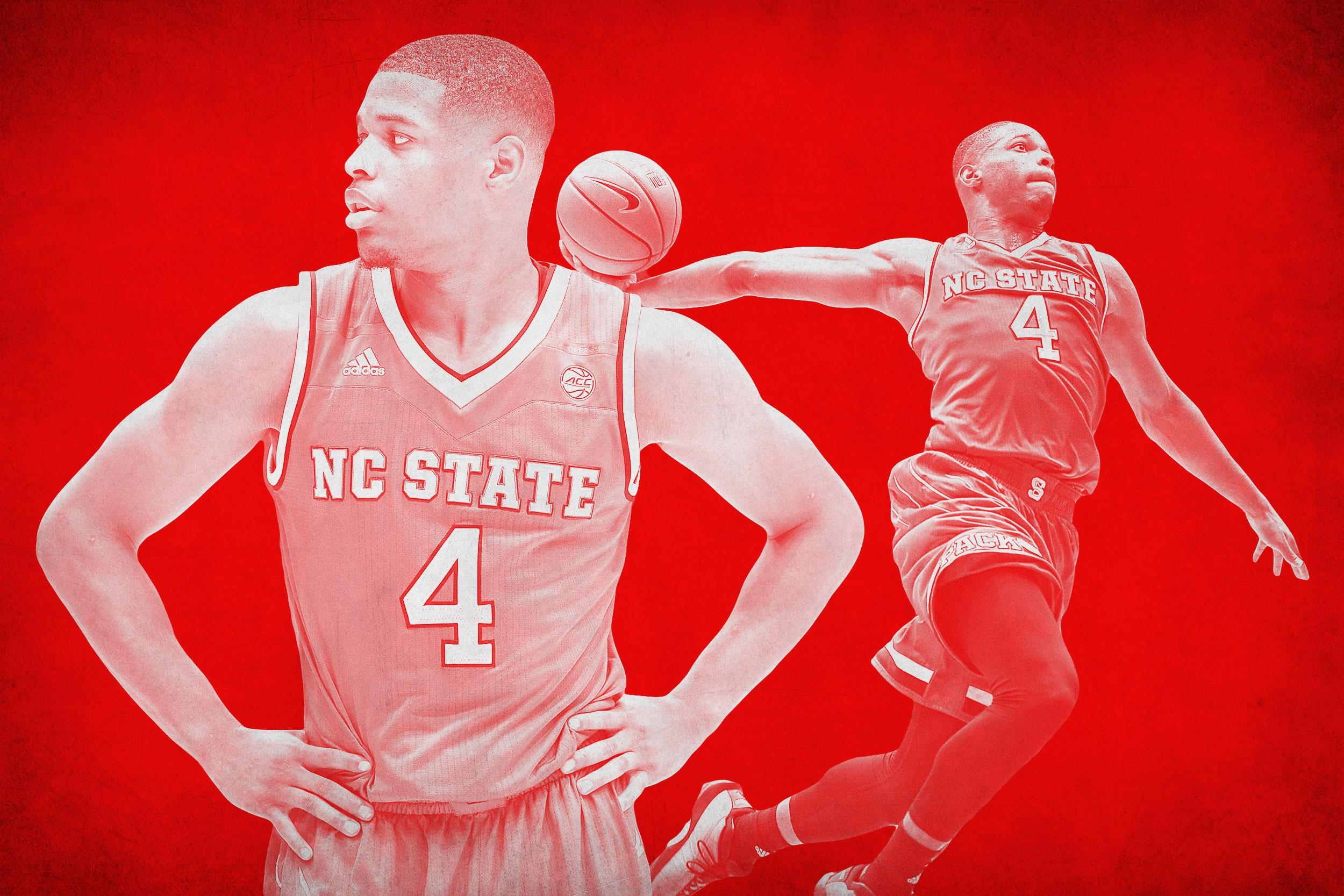
Not much went right for Dennis Smith Jr. in his one year at NC State. The Wolfpack were projected to finish sixth in the ACC before the start of the season, and they were widely expected to be an NCAA tournament team. Instead, they went 4–15 in ACC play and finished tied for 13th in a 15-team conference. The disaster cost coach Mark Gottfried his job. While Smith was the ACC Freshman of the Year, a point guard is supposed to make his teammates better, but NC State’s season suggests he did the opposite. As a result of his team’s record, he’s not seen as being in the same class as guys like Lonzo Ball and De’Aaron Fox, whose teams were among the best in the country. Players with Smith’s talent rarely slip to the end of the lottery, and he could be one of the biggest steals in this year’s draft if he ends up in the right situation.
At 6-foot-3 and 195 pounds, Smith has a rare combination of speed and power at the point guard position. He may not be Russell Westbrook or John Wall, but he’s easily the most athletic floor general in this year’s draft. My favorite play of his came at the buzzer of NC State’s 84–82 upset of Duke, when Smith nearly tore down Cameron Indoor Stadium with this rim-rattling dunk. The sheer amount of disrespect packed into this 24-second clip warms my heart:
Plays like that are even more impressive when you consider that he’s coming off an ACL tear in August of his senior year of high school. It’s scary to think about what a faster and more explosive version of Smith could do:
What makes Smith such an intriguing prospect is that he’s not just an athlete. Most über-athletic guards struggle with shooting the ball from the perimeter, reading the floor, controlling tempo, and picking and choosing the right moments to smash the turbo button. Think post-surgery Derrick Rose on the New York Knicks. The most surprising thing about Smith is how under control he plays.
Opposing teams did everything in their power to take the ball out of his hands: He faced multiple defenders almost every time he was involved in a pick-and-roll. For the most part, Smith took what the defense gave him. The problem was that he didn’t have big men who could make plays in four-on-three situations. There were many times this season when Smith delivered the ball in the right spot, only to see one of his teammates mess up the play:
It would be hard to blame Smith if he had decided to go full-YOLO, abandon the offense, and try to shoot NC State to victory every night. Instead, he remained calm, made the right play, and showed faith in his teammates. While he’s not a transcendent passer like Ball, he can make every pass in the book. He averaged 6.2 assists and 3.4 turnovers per game, giving him an assist-to-turnover ratio in line with Markelle Fultz and Fox. He’s more than capable of running an NBA offense, and making the right passes to keep the defense honest. Watch him wait the extra second for his big man to come open at the rim:
The amount of defensive attention Smith attracted was incredible. None of the big men in the Wolfpack rotation (Omer Yurtseven, Abdul-Malik Abu, Ted Kapita, and BeeJay Anya) could shoot 3s, so opposing teams packed the paint to take away Smith’s drives to the basket. Look at how much work he has to do to score on this play:
For as much as Smith has been criticized for not getting more out of his teammates, the NC State offense collapsed when he wasn’t in. Of the top four NCAA point guards in this year’s draft, Smith made the biggest impact on his team’s offensive rating (numbers courtesy of hooplens.com):

Smith is a well-rounded offensive player. He can attack the rim, finish through contact, get to the free throw line, and knock down 3s off the dribble. He leads the elite point guards in this year’s draft in free throw rate, and trails only Fox when it comes to the percentage of shots he takes at the rim. The only one with a higher field goal percentage at the rim was Ball, and over half his shots were assisted, an indication of how well UCLA spaced the floor and moved the ball, and how many different threats the Bruins had on offense (numbers courtesy of hoop-math.com):

Smith and Fox, as you would expect given their athletic gifts, were the best at getting into the lane. The difference between the two is that Fox can’t shoot to save his life. Smith isn’t as much of a perimeter threat as Ball or Fultz, but he made enough 3s (35.9 percent from 3 on 4.8 attempts per game) to keep defenses honest. While he will need to continue working on his shot at the next level, it’s much easier to go from being an average shooter to a good one than it is to go from a bad shooter to an average one. There are no glaring mechanical errors in his shot; it could just be a matter of putting in hours at the gym and improving his shot selection. He doesn’t need to make any major changes to his game. He’ll be ready to walk in on day one and be given the keys to an NBA offense.
The big concern for Smith is on the other end of the floor. He has a below-average reach for a player his size (6-foot-3 wingspan), making it difficult for him to contest shots. According to the tracking numbers at Synergy Sports, Smith was in the 14th percentile of players in the country at defending spot-up shots, a measure of how effective Smith was at deterring shots and how close he stayed to his man off the ball. Switching screens will be difficult for Smith at the next level, as bigger players can shoot over the top of him pretty easily:
According to the numbers at hooplens.com, NC State’s defensive rating was five points higher (allowing 111 points per 100 possessions) when he was on the floor than it was when he was off (allowing 106 points per possessions). Those numbers aren’t hard to believe when you see the effort level that Smith put in on defense. To be charitable, he wasn’t in Raleigh to lock anyone up. In this sequence, Smith strolls around the middle of the lane for a few seconds rather than go after the defensive board. This is the kind of play that will cause his NBA coaches to consider benching him, if not outright skewering him:
Smith has the speed and physicality to fight through screens and track his man around the court when he feels like it. He just didn’t feel like it all that often at NC State. However, Smith is far from the only young point guard to give inconsistent effort defensively, and it’s just as easy to find sequences from this season where Fultz or Ball gave up on plays, died on screens, and didn’t give adequate effort. At the next level, guys like Kyrie Irving, Damian Lillard, and Isaiah Thomas aren’t exactly known for their defense, yet they have still managed to become elite players. Because they are involved in so many screens over the course of a game, defending point guards in the NBA is a team effort, and good coaches can find ways to hide offensive-minded guards defensively without handicapping their teams.
The biggest problem for NC State under Gottfried was his inability to coach defense. Considering the types of athletes he recruited to Raleigh in his six seasons there, there’s no excuse for how bad his teams were on that side of the ball. The Wolfpack’s average national defensive ranking under Gottfried was 233rd, and they didn’t finish in the top 150 once. The result was a program that consistently underachieved. While NC State made two Sweet 16s under Gottfried, they did it as an 11-seed and an 8-seed, which tells you he wasn’t doing much with that talent in the regular season. The ACC is the best basketball conference in the country, and a coach at one of the programs below the level of blue bloods like Duke, UNC, Syracuse, and Louisville has to be really good to survive long-term. It’s not easy for a coach to win consistently at NC State, and Gottfried wasn’t long for the job, regardless of who was on his team this season.
Smith walked into a very tough situation in college. Lonzo played with TJ Leaf and Ike Anigbogu, while Fox had Malik Monk and Bam Adebayo on his team; Omer Yurtseven (no. 62) is the only other NC State player ranked among the Top 100 NBA prospects by DraftExpress. And while Smith had more talent at his disposal than Fultz did at Washington, his team also faced a more difficult slate of opponents. Of the 19 games on NC State’s ACC schedule this season, 12 were against NCAA tournament teams and five were against NIT teams. Asking a freshman point guard coming off an ACL injury to lead NC State anywhere this season was unrealistic. Fultz’s team dramatically underperformed preseason expectations as well, and no one holds it against him.
To be sure, Fultz is a better prospect than Smith. He’s bigger, longer, and a much better shooter. However, the difference between Smith and Ball and Fox isn’t as wide as commonly perceived. Smith doesn’t have as defined a weakness as Ball, whose lack of quickness in comparison to many primary ball handlers was exposed by Fox in the NCAA tournament, or Fox, who has to become a much better shooter. Smith’s floor is higher than both because his elite athletic ability and well-rounded skill set means he will be able to run an NBA offense at a high level even if he doesn’t get any better. If he plays in a spread pick-and-roll offense with a stretch 4 and a rim-rolling 5, he’s not going to have any trouble slicing up a defense. While Smith will never be great defensively, if he can become even average, he has a chance to be an All-Star-caliber player. In five years, no one will care how good his college team was. It shouldn’t matter all that much right now, either.

